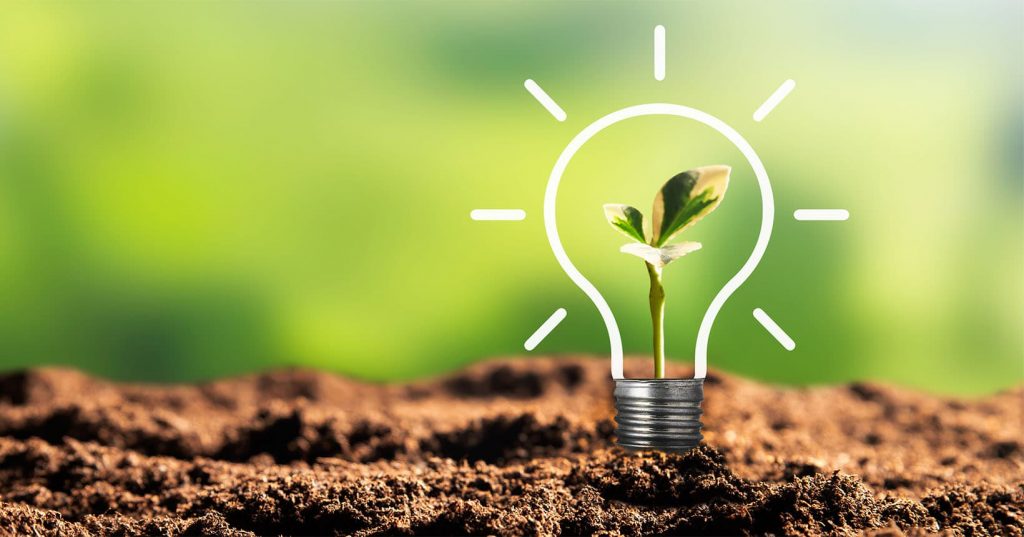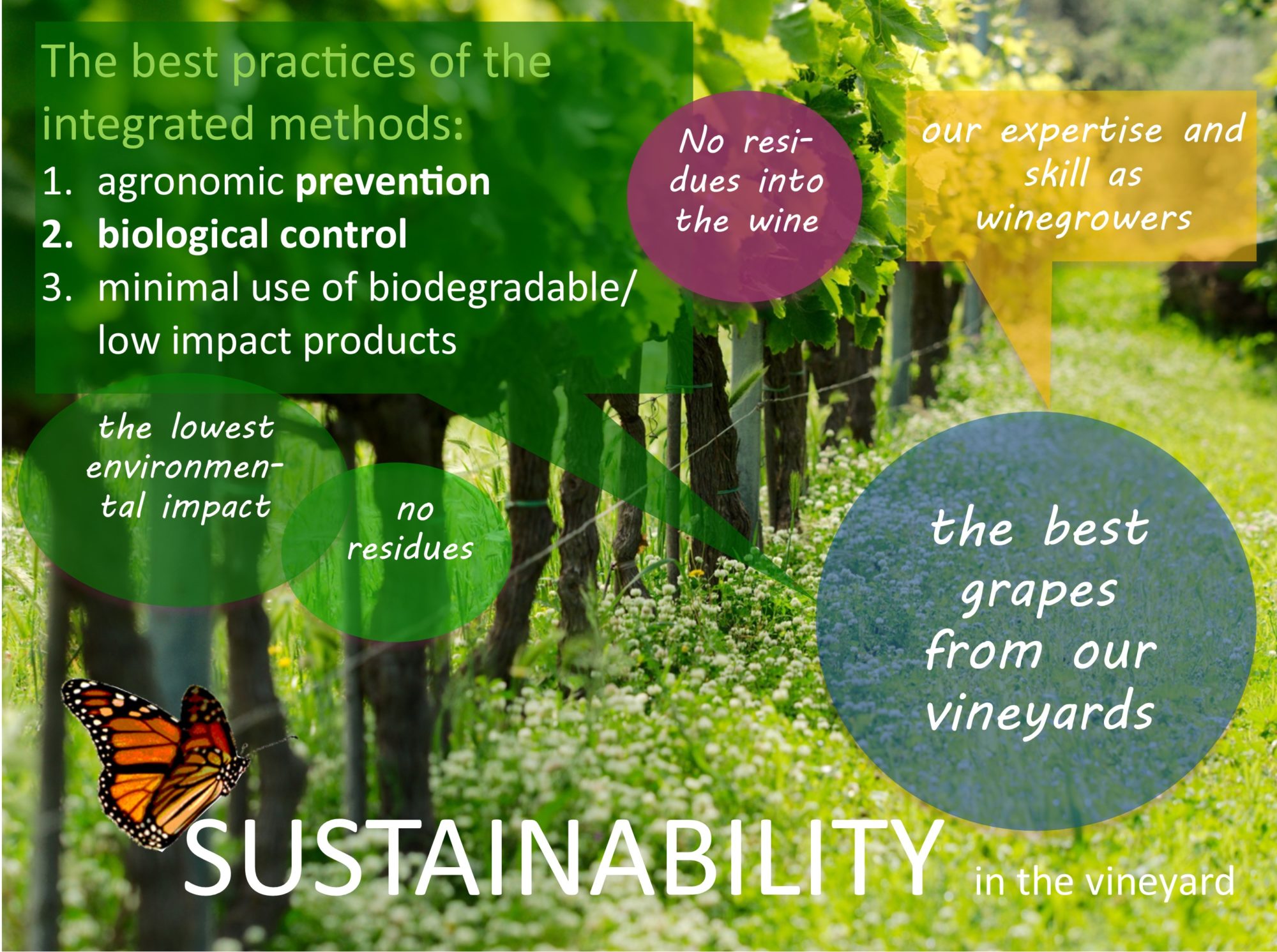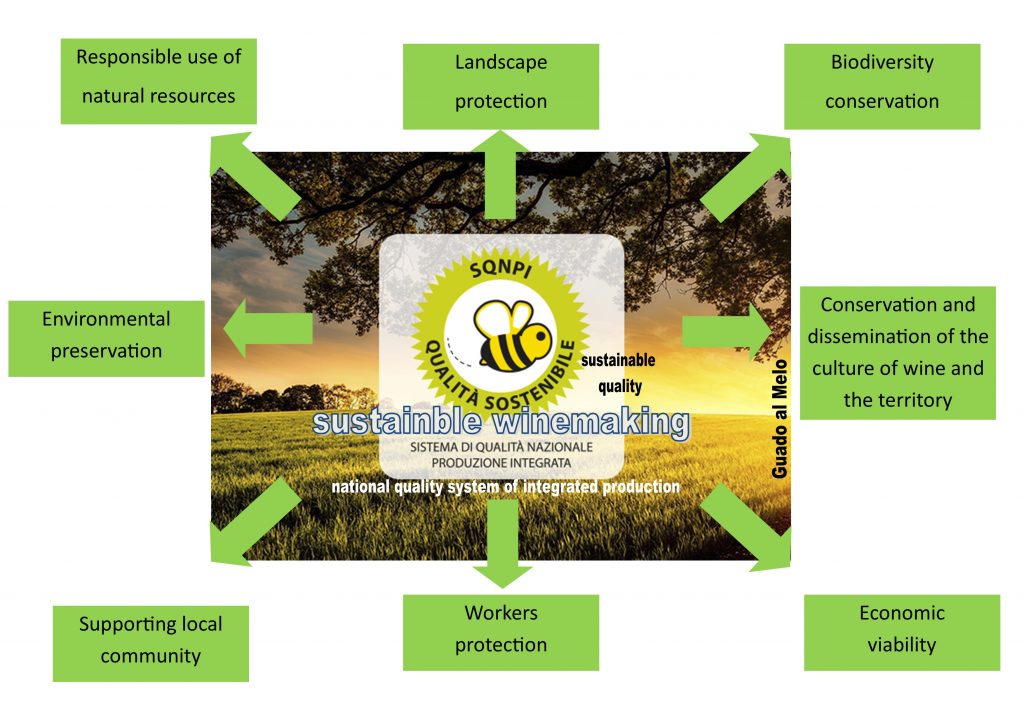Be the change you want to see in the world.
(Gandhi)
I am glad to inform you that with the 2022 harvest our wines will be certified for the production of sustainable wine, according to the single sustainability standard set this year by the Italian Ministry, with the SQPNI mark (National Quality System of Integrated Production). The logo is the nice bee you see above, very evocative of a winegrowing that respects the environment and health. However, do not stop at this somewhat naïve appearance: there is a very rigorous and solid technical-scientific system at the base, that of integrated viticulture
We don’t become sustainable now because we certify ourselves. Conversely, we certify something we have always been doing. Those who know us know that, since the birth of Guado al Melo, we have been working to make it a completely sustainable artisan company (on the management of the vineyard, the bio-architecture cellar, the management of winemaking, the recycling of rainwater, the spreading of the culture of wine and the territory, …). We are sustainable in essence, in our way of life and in the constancy of evolving over time.
Our certification starts with the 2022 harvest. You will therefore have to wait a while to see the pretty bee on our labels. The first wine will be the Airone 2022, which will be released more or less in March 2023. Then it will be all the others.

Is it necessary to be certified? I think that the certification systems can have limits, which is why we have not certified ourselves with systems we did not believe in. If the system is done well, however, it is an extra guarantee towards our customers.
Why only now? We waited for Italian politics to define a single sustainability certification system, based on a rigorous technical-scientific system. He did it late and, as always, in a tortuous and somewhat confused way. However, we are confident that we are at the beginning of a path that will be increasingly fruitful.
It is not our first experience. The Tuscany region has been verifying our adhesion to voluntary integrated viticulture for twenty years. A few years ago we had already participated, as a pilot-winery, in the birth of the first Italian sustainability certification, called Magis. The project, born in 2009, supported by several universities and research centers, was very rigorous. He was recognized among the best in the world by the OIV. Unfortunately, it ended after a few years, because it was too ahead of its time: many wineries pulled out because they did not see a vantage of image.
Sustainability was born from the evolution of integrated agriculture (integrated pest control) in the 90s. A few years later, some national certification systems were born in the wine-growing countries of the New World (first in California, then New Zealand, Chile, South Africa, …).
Italy (and Europe) lagged behind in terms of certifications of sustainability. Until now, there were only the regional regulations of the integrated viticulture, which is very excellent in Tuscany (my region, I have few knowledge of the other Italian regions). Sustainability spread in the society in recent years. Some certifications have thus been created recently, which have benefited from the rigorous system already set up by Magis. This year the Italian Agriculture Ministry has started working to define a single sustainble standard, based on the SPQNI system.
Unfortunately, this delay is due to the fact that in Italy (and Europe) the public debate on agriculture/environment issues has not always been dominated by the rationality, but often by clichés and romantic “natural” practices, perfect for politics or the most superficial media or corporate marketing, but little or not at all effective in the winegrowing.
If we really want to do good for the environment and for ourselves, the essential thing is not to stop at attractive slogans but to work to find truly effective methods that allow us to achieve concrete goals. In fact, despite all this, the world viticulture research has worked a lot in recent decades and many winemakers have kept up with the it.
How the sustainable certification works
The pillars of sustainability are three, closely intertwined with each other: the environmental, economic and social.
The protection of the environment and health in the vineyard passes first of all from the technical-agronomic practices, which are based on voluntary integrated viticulture (which we have always done and which I have therefore told on our website and in some posts here). It includes multi-disciplinary viticultural practices that allow for high quality grapes with the lowest (measured) impact on the environment. Other check points are added to it. Some are related to the work in the cellar: the traceability of each wine from the field to the finished bottle, the containment of the winemaking products (we do not use any), the verification of the absence of residues in the finished wine. Moreover, there is a control of other winery’s general parameters, in relation to energy consumption, water saving, and the fate of waste.
If you don’t know what voluntary integrated viticulture is, I have written a reminder in the green box. If you know it, skip it.
What is the integrated viticulture? It is the most rational way to solve the environmental impact problems of viticulture. It is not a “philosophy” but simply the choice of the best practices available, taken from tradition and the best innovations, with the aim of minimizing human interventions and the use of each phytosanitary product in the vineyard (possibly up to elimination), maintaining at the same time an adequate quality and quantity of the grape (and wine). Therefore, a practice is accepted only if, at the same time, it satisfies two conditions: it works well and with the minimal impact on the environment. It is a system that benefits from decades of study and experimentation. The concept of “integrated pest management” was born in the 70s and has grown considerably over time, with an important leap especially in the 90s.P
Why is it called integrated? Because it considers the vineyard as an integrated ecosystem in which numerous living organisms interact, influenced by the situation of the soil, climate and atmospheric variations. The multidisciplinary approach only, which manages to bring together all the knowledge on these elements, allows for the minimum possible impact in agriculture.
Some key concepts: Among the practices used there is a priority scale. Those that allow the prevention of adversity are always favored first. Where this is not possible, biological control systems are used. If even this is not possible, there is the use of plant protection products, chosen from those that have demonstrated excellent effectiveness and the lowest impact on the environment. They are used the smallest amount possible, only where it is needed. In this way, we can achieve a very low impact, which research is trying to lower more and more. To make decisions, it is essential to collect the data that allow us to understand what is happening in the vineyards (from observation to the collection of atmospheric data, …) so as we promptly intervene with the best methods for that particular situation, only where it is needed. A fundamental principle is the integrated approach: each problem is faced from several fronts, in order to minimize the impact of each intervention. Another basic principle is the damage threshold, that is, there is no need to “sterilize” the vineyard, but it is sufficient that the adversities are below a minimum threshold that does not affect the quality of the grapes.

Why is it little talked about ? Honestly, it has always been my question! Even if it is not famous, it is applied by many companies of Italian (and worldwide) winemakers. Above all, I always wonder why wineries, universities, regions and the technicians who deal with it hardly ever talk about it. Or are they not listened to?!?! I have given myself several explanations. It is a complex system, not very suited to the simplicity required by the media and marketing, which want concepts that are not well reasoned, easy and charming. In my experience, I also realized that this system is generally chosen by old-fashioned winemakers’ companies, which do not put marketing first but the optimal care of the vineyard, which on average are bad communicators (sorry, but unfortunately this is the case ).
However, it is not enough. Parameters relating to the economic and social sphere are also verified to complete the concept of sustainability. There are a series of checks on the integrity of the winery in relations with its workers, as regards safety and enhancement, as well as in relations with the territory and the rest of the production chain.
What is sustainable viticulture? It is the upgrade of the integrated viticulture. In the 90s, the scholars began to reflect on the fact that it was not enough to consider the impact in the environmental field. A complet sustainability must be integrated with the economic and social aspects.
Economic sustainability. For example, let’s assume that I find a cultivation practice that does not have a negative impact on the environment but makes me produce very little product or it is of poor quality, or it costs me a lot to produce it … So, that practice is not sustainable, because it solves one problem but creates many others. Agriculture must give income to the people, otherwise it risks disappearing or it must depend on public funds to survive. It must also offer sufficient food products to meet the needs of the community, both in quantity and quality. In reality, this basic concept has always been inherent in the integrated viticulture, which has always sought practices with the lowest environmental impact but which, at the same time, maintain an adequate qualitative and quantitative level of the grape.
Social sustainability. Furthermore, every human activity must include respect for the workers and people who live in the area, fairness towards suppliers and customers (and the whole chain that is before and after), supporting the local community, maintenance and the spread of the culture of the wine and the territory, …
All these elements must coexist in the sustainable viticulture, or better, we must found the best possible mediation between them.

It is a supply chain and product certification. It means, unlike others, that we must demonstrate every year not only to follow some practices, but that there are the goals of the absence of residues in the vineyard and in the wine. So, we can “conquer” the bee on our bottles.